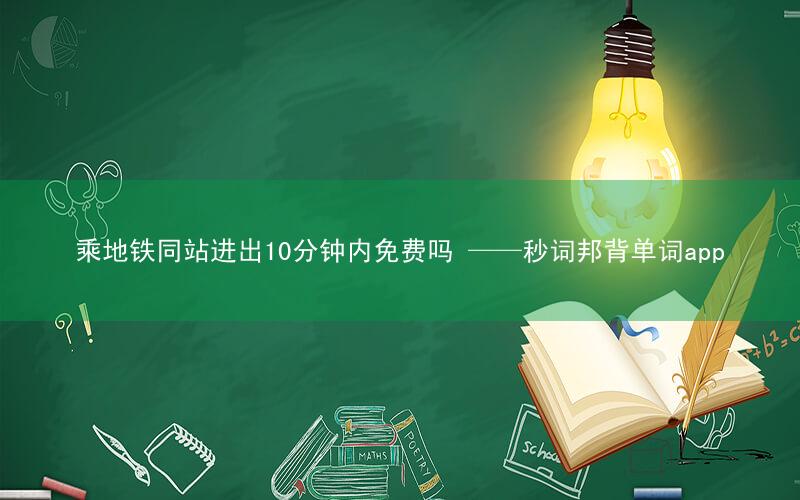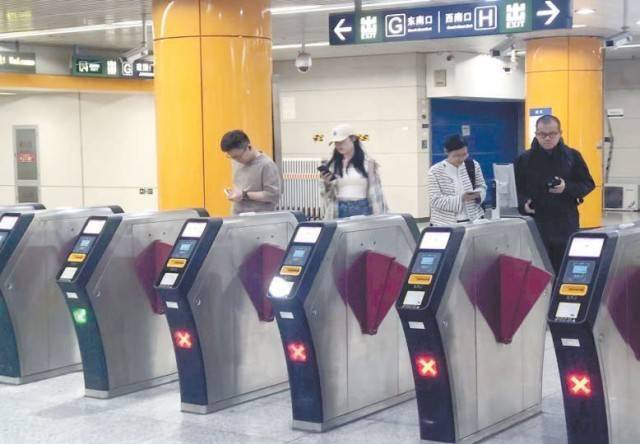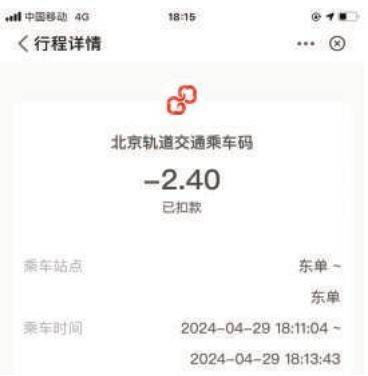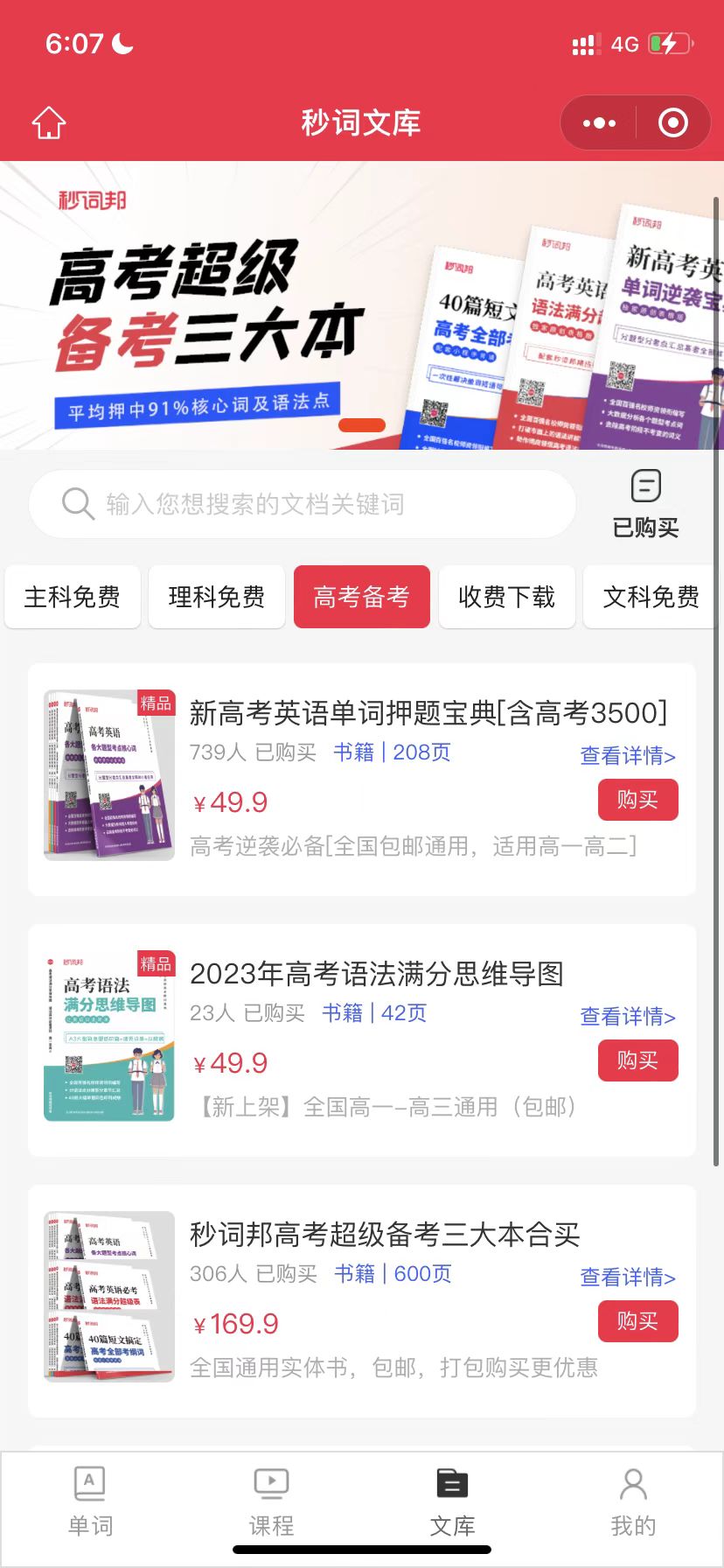单词很忙
分题型分考点背单词 文
文
顺利退费将为市民和游客带来更多便利
乘地铁同站进出10分钟内免费吗

当前,多数乘客乘坐地铁都是扫码进站。

在短时间内从同站点出站,仍然会被扣费。
4月26日,本报曾报道有乘客扫码进入北京地铁机场线后,因行程改变很快决定不乘坐机场线,但遭遇退费难的问题。据悉,上海地铁日前推出新规――同站进出10分钟内不收费。即乘客临时有需求在同一站点进出,只要在10分钟内,可至车站服务中心进行人工退费处理。北京地铁有无类似规定?现金、扫码支付退票流程是否便利?记者对此继续进行追踪调查。
体验1 购买临时票卡3分钟办妥退票
4月29日至5月5日,本报记者多路出击,在本市多条地铁线路采用不同的支付方式就退费问题进行体验。结果发现,在乘客临时有需求在同一站点进出时,购临时票卡退费的处理方式简单便捷。
在多个地铁站,记者首先选择通过自助机购买临时票卡。实验同站点进出时,记者考虑到两种情况。第一种情况是,刷临时票卡进站后,立即找工作人员说明情况,工作人员可以查询临时票卡的使用情况并进行退费。另一种情况是,出站时已经将临时票卡投入了闸机,求助工作人员时无法提供凭证,只能请工作人员查询记录。
实验结果表明,无论乘客是否手持临时票卡,退费流程都可以在3分钟以内办妥,过程中没有遇到任何阻碍。
体验2 扫码支付想退费麻烦不断
相比之下,如果是通过支付宝、北京一卡通等App扫码进站后,同站进出想退费就要麻烦得多。记者使用不同App进行体验,大多数App在乘客同站进出时都扣了费。例如在地铁东单站,记者无论是乘坐地铁1号线还是5号线,进出站时间仅相隔2分多钟,App的行程单中也有明确记录,但出站时还是扣了费。这样的情况站内工作人员无法处理,只能让乘客自行联系App所属公司的客服。
其中一些App有人工服务的电话,还有一些则连电话都没有,需要乘客在问题反馈栏里输入大量文字,说明为何需要在同站进出,最终是否能退费,还需客服人员向上级汇报。除此之外,还有个别App遇到乘客短时间内同站进出的情况时,长时间显示此次行程是在“行程中”,而并未立即结算。乘客发现,3至5天后,行程结算才完成,结果显示同样被扣了费。
记者咨询一些App客服时得知,其实在北京地铁的同站点进出扫码支付退费问题上,早已有“10分钟原则”,即乘客同站点进出站相隔时间不超过10分钟,是能够受理退费诉求的。但是,一方面,乘客无法通过在站内向工作人员求助直接退费;另一方面,很多乘客反映,求助App客服时被问到的问题也经常令人不太舒服。
“您进错地铁站了?您本来是想去哪儿?”很多乘客反映,在地铁机场线,如三元桥站、北新桥站,有个别乘客误入机场线退回闸机,准备改乘5号线、10号线列车时,总被支付平台的客服问到这样的问题,不仅如此,乘客还需要改换到5号线、10号线扫码进出站,才能证明自己确实是误入了机场线。
“有必要告诉他人我的目的地吗?如果因为临时情况我无需换乘其他地铁线的话,难道就不能退费了吗?”乘客认为,“10分钟原则”不仅应是受理退费诉求的条件,也应是支付平台自动退费的充分条件。
调查中还发现,部分App在使用过程中,短时间内同站点进出站被判定为正常支付,即使联系客服也不能退费。
体验3 “10分钟原则”能够证明未乘车
针对乘客提出的“10分钟原则”应成为自动退费的充分条件,记者进行了实验,即需要证明10分钟之内,能否搭乘地铁并返回原站点,造成并未乘车的假象。这项实验的目的是验证“10分钟原则”能否成为未搭乘地铁的直接证据。
在实验中,记者选择了多个行程较短(两站距离在600米左右)的站点,例如地铁5号线雍和宫站至北新桥站(仅一站地)、地铁1号线东单站至建国门站(仅一站地)。为了追求极致,记者掐表计算的时间只包括从刷卡进站到快速步行至站台的时间,以及乘车时间,排除需要候车的时间。测算发现,这些距离很短的两站地,乘客往返的平均用时为7分35秒。
需要注意的是,虽然看似10分钟内,乘客在极端情况下有可能享受了地铁乘车服务,但有几个条件需要同时满足。首先,两站之间行程必须非常短,乘车时间要控制在2分钟内。其次,进站后没有候车时间,抵达站台时列车要正好进站,返程亦是如此,下车后对向地铁列车也需要刚好进站。第三,不能赶上乘车高峰期,因为这会大大降低站内步行速度,乘客从闸机到站台一定得大步流星。从北京地铁的现实情况来看,这些条件很难同时满足。以最快速度进站,乘一站地铁马上折返,然后谎称自己并未乘坐地铁,这样的概率极低。
记者又模拟了现实中的正常乘车情况,例如需要等车、站台里人流量较大等,在多个短程站点反复乘车测试,乘地铁一站地往返需要的平均时间为13分35秒,而客流高峰期则需要15至16分钟。可见,10分钟不可能享受地铁乘车服务并从同站点出站是普遍情况。
建议让地铁站发挥更大作用
不少市民建议,地铁方经过科学评估后,确定合理时间范围作为乘客未乘车的直接证据,从而实现自动退费。这么做不仅能够方便搭乘地铁的乘客,还能给很多其他需求的市民提供便利。
在北京,地铁站进出站口的设置大多数情况下是在马路的两侧,或在十字路口的四个角。与进入地铁站后突然需要改变行程相比,乘客需要同站点进出站更普遍的原因是出错了站口。如果乘客出站后发现,自己的目的地其实是十字路口斜对角的站口,从地面上过两次马路,或者走过街天桥都很麻烦,如果能从地铁站内穿行可以省不少事儿。
记者调查发现,如果各类支付App能够支持合理时间内(如10分钟)同站点出站自动退费,不仅可以为出错站口的乘客提供方便,还将为有过街需求的老人及残障人士提供重要的帮助。
以地铁5号线北苑路北站为例,该座地铁站还肩负着过街天桥的作用。地铁5号线北段纵贯北苑路,这段路上能过马路的地方不多,在很多区域,行人需要绕行至大路口,或走过街天桥。绕路、爬楼梯让老人和残疾人非常头疼。但是在地铁5号线北苑路北站,他们可以搭乘扶梯或残疾人升降梯由地铁站厅过街。站内的设置显然考虑到了这个需求,特意留出了免费通道,有过街需求的行人无需购票,从这条通道就可以抵达马路对侧。而观察其他地铁站,记者发现很多车站由于空间等限制无法单独设置免费通道,如果市民穿行这些车站可以享受自动退费,地铁站这种交通设施就可以发挥更大的作用。
记者还发现,在公共服务方面,地铁站还可以为市民和游客提供很多便利。例如行人突然有如厕需求时,恰好周边找不到公厕,真是着急。而北京的多数地铁站都有公厕,可公共厕所是设置在站台内的,即乘客刷卡、扫码进站后才能使用。如能实现短时间内同站点进出站自动退费,就可以为内急的行人提供更多便利。
据媒体报道,目前包括郑州、洛阳、青岛等一批城市的地铁轨道交通已经实现了“公厕共享”服务。市民无需支付地铁进站费用,便可以进站如厕。相信“10分钟同站进出免费”政策更好地落地后,北京地铁站会为市民和游客提供更多贴心服务。
北京日报记者 景一鸣 实习生 杨沁萱 文并摄
新闻译文:
Smooth refund will bring more convenience to citizens and tourists
Is it free to enter and exit within 10 minutes by subway at the same station
Currently, most passengers take the subway by scanning the QR code to enter the station.
Leaving the same site within a short period of time will still result in fees being deducted.
On April 26th, this newspaper reported that a passenger who scanned the QR code and entered the Beijing Subway Airport Line quickly decided not to take the airport line due to a change in itinerary, but encountered difficulties in refunding fees. It is reported that the Shanghai Metro has recently launched a new regulation - no charge for entering or exiting within 10 minutes at the same station. If passengers have a temporary need to enter and exit at the same station, they can go to the station service center for manual refund processing within 10 minutes. Is there a similar regulation on the Beijing subway? Is the cash and QR code payment refund process convenient? The reporter continued to investigate this matter.
Experience 1: Purchasing a temporary ticket card takes 3 minutes to complete the refund process
From April 29th to May 5th, our reporter made multiple attempts to experience refund issues on multiple subway lines in the city using different payment methods. It was found that when passengers have a temporary need to enter and exit at the same station, the processing method for refunding temporary ticket cards is simple and convenient.
At multiple subway stations, the reporter first chose to purchase temporary ticket cards through self-service machines. When entering and exiting the same site during the experiment, the reporter considered two situations. The first scenario is to immediately inform the staff of the situation after swiping the temporary ticket card into the station. The staff can check the usage of the temporary ticket card and make a refund. Another scenario is that the temporary ticket card has already been put into the gate when exiting the station, and when seeking help from the staff, they cannot provide a voucher and can only ask the staff to check the record.
The experimental results show that regardless of whether passengers hold temporary ticket cards or not, the refund process can be completed within 3 minutes without encountering any obstacles during the process.
Experience 2: Scan the QR code for payment, but if you want a refund, it's troublesome
In contrast, it would be much more troublesome to get in and out of the same station and want to refund fees if you entered the station by scanning the code through Alipay, Beijing all-in-one card and other apps. Journalists use different apps for experience, and most apps deduct fees when passengers enter and exit at the same station. For example, at the Dongdan subway station, whether the reporter takes Line 1 or Line 5, the entry and exit time is only more than 2 minutes apart. The itinerary of the app also clearly records it, but the fee is still deducted when leaving the station. In such a situation, the station staff cannot handle it and can only allow passengers to contact the customer service of the company to which the app belongs.
Some of these apps have phone numbers for manual services, while others do not even have a phone number. Passengers need to enter a large amount of text in the problem feedback column to explain why they need to enter and exit at the same station, whether they can ultimately receive a refund, and customer service personnel need to report to their superiors. In addition, there are also some apps that display for a long time that the trip is "in progress" and not immediately settled when passengers enter and exit the same station in a short period of time. The passenger found that the itinerary settlement was not completed until 3 to 5 days later, and the result showed that the fee was also deducted.
When the reporter consulted some app customer service, it was found that in fact, there is already a "10 minute principle" on the issue of scanning and paying refunds for passengers entering and exiting the same station on the Beijing subway, which means that the time interval between passengers entering and exiting the same station does not exceed 10 minutes, and refund requests can be accepted. However, on the one hand, passengers are unable to seek direct refunds from staff at the station; On the other hand, many passengers have reported that the questions they are asked when seeking help from App customer service are often uncomfortable.
"Did you enter the wrong subway station? Where did you originally want to go?" Many passengers reported that on the subway airport line, such as Sanyuanqiao Station and Beixinqiao Station, some passengers mistakenly entered the airport line and returned to the gate. When preparing to transfer to the 5 or 10 lines, they were always asked such questions by the customer service of the payment platform. Moreover, passengers also need to switch to the 5 or 10 lines and scan the code to enter and exit the station in order to prove that they have indeed entered the airport line by mistake.
"Is it necessary to inform others of my destination? If I don't need to transfer to another subway line due to temporary circumstances, can't I get a refund?" The passenger believes that the "10 minute principle" should not only be a condition for accepting refund requests, but also a sufficient condition for the payment platform to automatically refund.
During the investigation, it was also found that some apps were deemed to have made normal payments for entering and exiting the same site within a short period of time during use, and even if customer service was contacted, the fees could not be refunded.
Experience 3 "10 minute principle" can prove that one has not taken a ride
In response to the passenger's suggestion that the "10 minute principle" should become a sufficient condition for automatic refund, the reporter conducted an experiment to prove whether it is possible to take the subway and return to the original station within 10 minutes, creating the illusion of not taking the train. The purpose of this experiment is to verify whether the "10 minute principle" can become direct evidence of not taking the subway.
In the experiment, the reporter selected multiple stations with shorter travel distances (about 600 meters between the two stations), such as Yonghegong Station to Beixinqiao Station on Metro Line 5 (only one station), and Dongdan Station to Jianguomen Station on Metro Line 1 (only one station). In pursuit of perfection, the reporter calculated the time from swiping the card to walking quickly to the platform, as well as the travel time, excluding waiting time. Calculations have found that the average round-trip time for passengers between these two short distance stations is 7 minutes and 35 seconds.
It should be noted that although it appears that passengers may have enjoyed subway ride services in extreme situations within 10 minutes, there are several conditions that need to be met simultaneously. Firstly, the journey between the two stations must be very short, and the travel time should be controlled within 2 minutes. Secondly, there is no waiting time after entering the station. When arriving at the platform, the train must enter the station exactly, and the same applies to the return journey. After getting off, the train facing the subway also needs to enter the station exactly. Thirdly, it is not possible to catch the rush hour of taking the train, as this will greatly reduce the walking speed inside the station, and passengers will have to take big strides from the gate to the platform. From the reality of the Beijing subway, it is difficult to meet these conditions simultaneously. The probability of entering the station at the fastest speed, taking the subway and immediately turning back, and then falsely claiming that you have not taken the subway is extremely low.
The reporter also simulated normal train situations in reality, such as waiting for trains and high passenger flow on the platform. After repeated train tests at multiple short distance stations, it took an average of 13 minutes and 35 seconds to travel back and forth by subway, while during peak passenger flow, it took 15 to 16 minutes. It is common to see that it is impossible to enjoy subway ride services within 10 minutes and exit from the same station.
Suggest allowing subway stations to play a greater role
Many citizens suggest that after a scientific evaluation, the subway company should determine a reasonable time frame as direct evidence of passengers not taking the train, in order to achieve automatic refund. This not only facilitates passengers taking the subway, but also provides convenience for many citizens with other needs.
In Beijing, the entrances and exits of subway stations are mostly located on both sides of the road or at the four corners of intersections. Compared to the sudden need to change itinerary after entering a subway station, the more common reason for passengers to enter and exit the station at the same station is due to making mistakes at the station entrance. If passengers find that their destination is actually a diagonally opposite intersection after exiting the station, crossing the road twice from the ground or crossing a pedestrian overpass can be troublesome. It can save a lot of trouble if they can walk through the subway station.
The investigation by reporters found that if various payment apps can support automatic refund at the same station within a reasonable time (such as 10 minutes), it can not only provide convenience for passengers at the wrong station entrance, but also provide important assistance for elderly and disabled people who need to cross the street.
Taking the North Yuan Road Station of Metro Line 5 as an example, this subway station also serves as a pedestrian overpass. The northern section of Metro Line 5 runs through Beiyuan Road, and there are not many places to cross the road on this section. In many areas, pedestrians need to detour to major intersections or cross pedestrian overpasses. Taking detours and climbing stairs can be a headache for the elderly and disabled. But at Beiyuan Road North Station on Line 5 of the subway, they can take escalators or disability elevators to cross the street from the subway station hall. The layout of the station clearly takes this requirement into consideration and has specially reserved a free passage. Pedestrians who need to cross the street do not need to purchase tickets, and can reach the opposite side of the road through this passage. Observing other subway stations, the reporter found that many stations cannot have separate free passages due to space limitations. If citizens can enjoy automatic refunds when passing through these stations, subway stations can play a greater role as transportation facilities.
The reporter also found that in terms of public services, subway stations can provide a lot of convenience for citizens and tourists. For example, when a pedestrian suddenly has a need to use the restroom and there is no public restroom nearby, it is really urgent. Most subway stations in Beijing have public toilets, which are located within the platform, allowing passengers to swipe their cards and scan the QR code before entering the station. If automatic refunds can be achieved for entry and exit at the same station in a short period of time, it can provide more convenience for pedestrians in urgent need.
According to media reports, a number of cities, including Zhengzhou, Luoyang, Qingdao, and others, have now implemented the "shared toilet" service in their subway and rail transit systems. Citizens do not need to pay the subway entrance fee to enter the station and use the restroom. I believe that with the better implementation of the "10 minute free entry and exit at the same station" policy, Beijing Metro Station will provide more considerate services for citizens and tourists.
Photo taken by intern Yang Qinxuan, Beijing Daily reporter Jing Yiming
退费 refund
乘地铁 by subway ; take the subway ; by underground
进站 get in ; pull in ; draw up at a station ; pull in (a station)
在短时间内 in a short time ; at short notice ; on short notice
被扣 Be detained ; comforter anchor
本报 this newspaper ; newspaper
行程改变 stroke alteration
服务中心 service center
退票 return a ticket ; get a refund for a ticket ; return
句子成分分析:
[According to media reports], a number of cities, <including Zhengzhou, Luoyang, Qingdao, and others>, have
[now] implemented the "shared toilet" service [in their subway and rail transit systems].
句子语法结构详解:
(media 为 medium 的复数形式。)
* Zhengzhou , Luoyang , Qingdao , and others 为同位语
* implemented 为谓语,采用现在完成时。
* shared 为谓语,采用一般过去时。
* their 为形容词型物主代词。other 为不定代词。have 为助动词。the 为定冠词。
句子相关词汇解释:
Phrase:
| according to | 根据,据(某人)所述 |
| a number of | 一些,若干 |
Vocabulary:
| medium ['mi:diәm] | n. | 1) (传播信息的)媒介,手段,方法 2) 手段,工具,方法 |
| report [ri'pɔ:t] | n. | 1) 报告,汇报,记述 2) 报道 |
| city ['siti] | n. | 1) 城市; 都市; 市 2) 全市市民 |
| including | prep. | 包括…在内 |
| Zhengzhou | n. | [中国省市] 郑州 |
| Luoyang | n. | [中国省市] 洛阳 |
| Qingdao | n. | [中国省市] 青岛 |
| and [ænd] | conj. | 1) 和, 与, 同, 并 2) 然后,接着 |
| other ['ʌðә] | n. | 1) 其他人, 其他的(事物) 2) 其余的人或事物, 剩下的人或事物 |
| now [nau] | ad. | 现在, 目前 |
| implement ['implimәnt] | vt. | 使生效,贯彻,执行,实施 |
| share [ʃєә] | vt. | 1) 分享,共享 2) 共有,合用 |
| toilet ['tɔilit] | n. | 1) 厕所,卫生间,盥洗室 2) 坐便器,抽水马桶 |
| service ['sә:vis] | n. | 1) 服务,接待 2) 公共事业 |
| subway ['sʌbwei] | n. | 1) 地下铁道,地铁交通 2) 地下人行道 |
| rail [reil] | n. | 1) 铁轨,轨道 2) 栏杆,扶手,围栏 |
| transit ['trænsit] | n. | 1) 运输,运载,搬运 2) 通过,通行,过境,中转 |
| system ['sistәm] | n. | 1) 系统 2) (思想或理论)体系 |
句子成分分析:
Citizens do not need to pay the subway entrance fee to enter the station and use the restroom.
句子语法结构详解:
* need 为谓语,采用一般现在时。
* to pay 为不定式,作宾语。
* to enter 为不定式,作状语。
* use 为不带 to 的不定式。
* do 为助动词。the 为定冠词。
句子相关词汇解释:
Vocabulary:
| citizen ['sitizn] | n. | 公民 |
| need [ni:d] | vt. | 需要,必需 |
| pay [pei] | vt. | 1) 付(费),付(酬) 2) 交纳,偿还 |
| subway ['sʌbwei] | n. | 1) 地下铁道,地铁交通 2) 地下人行道 |
| entrance ['entrәns] | n. | 1) 入口,门口 2) 入场,登场 |
| fee [fi:] | n. | 1) 费用 2) 报酬,服务费 |
| enter ['entә] | vt. | 1) 进入,进来,进去 2) 成为……的一员,加入,开始从事 |
| station ['steiʃәn] | n. | 1) 车站 2) 站,局,所 3) 广播电台,电视台 |
| and [ænd] | conj. | 1) 和, 与, 同, 并 2) 然后,接着 |
| use [ju:z] | vt. | 1) 使用,利用,运用 2) 消耗 |
| restroom | n. | (公共场所的)盥洗室,洗手间;公共厕所 |

以上是蜂贝为您整理编写的文章《乘地铁同站进出10分钟内免费吗 ——秒词邦背单词app》的全部内容。蜂贝是国内权威分题型分考点背诵中高考/四六级考研/专升本/出国单词的专业单词软件。扫描如下小程序码,进入蜂贝官方小程序获取更多英语相关资料! 【关键词:高考单词;高考英语;高中单词;高中英语;单词app;单词软件;记单词app;记单词软件;背单词软件;背单词app;英语单词;四六级单词;四六级英语;四六级单词app;四六级单词软件;考研单词app;考研单词软件;核心单词;高考冲刺复习;高考英语教材;高考英语真题;四六级真题;四六级试题;考研真题;考研英语单词;考研英语真题】





